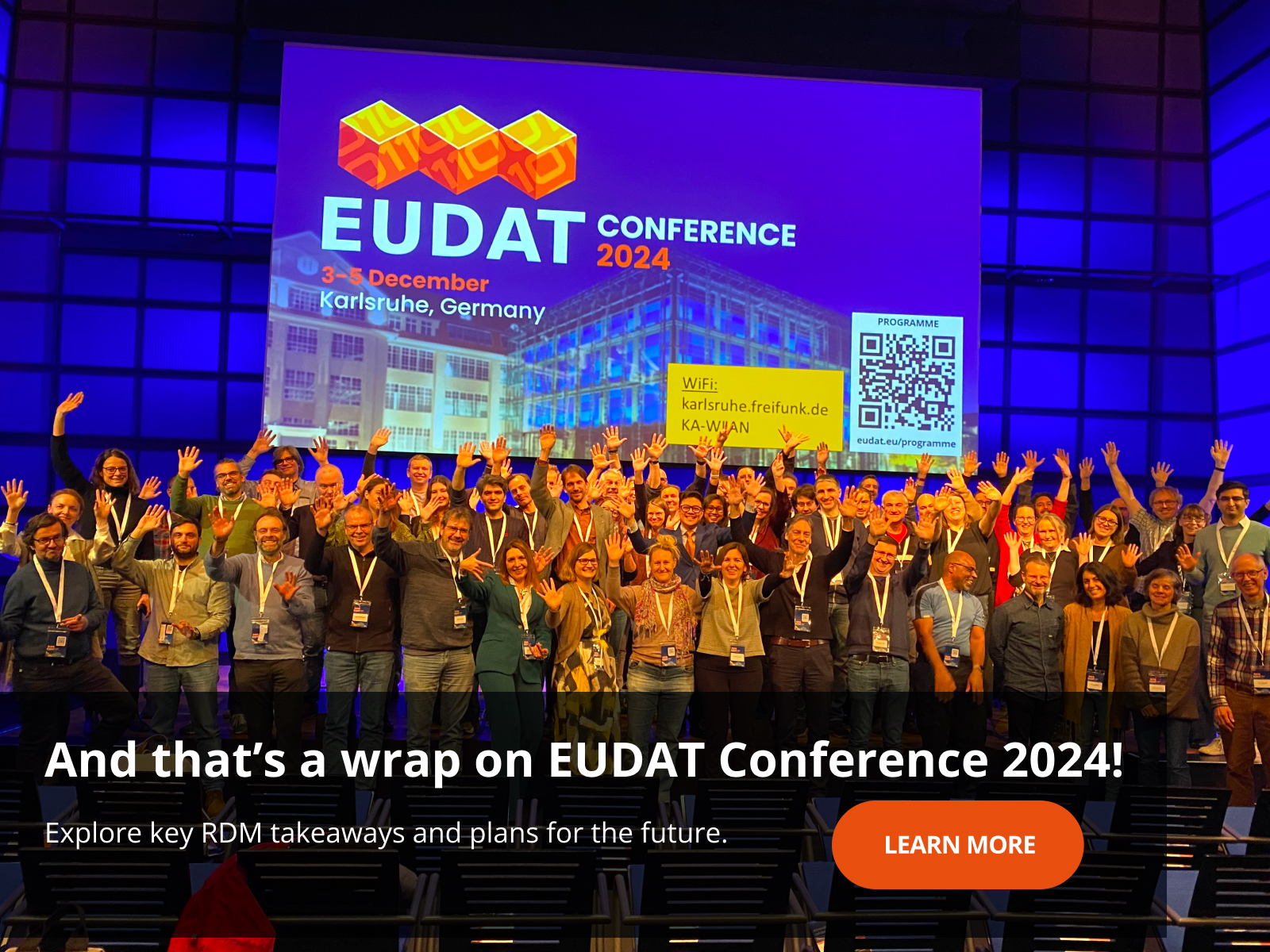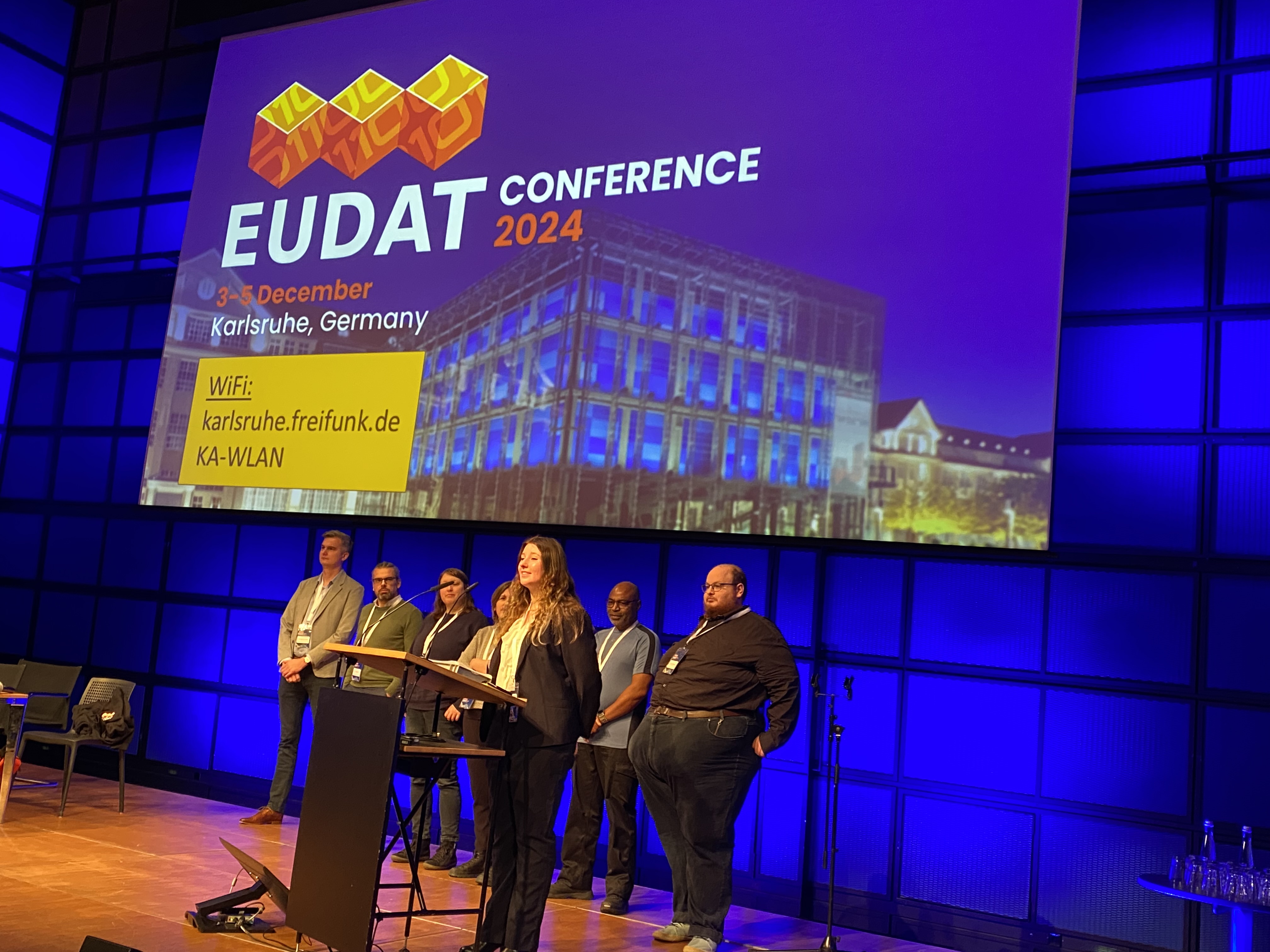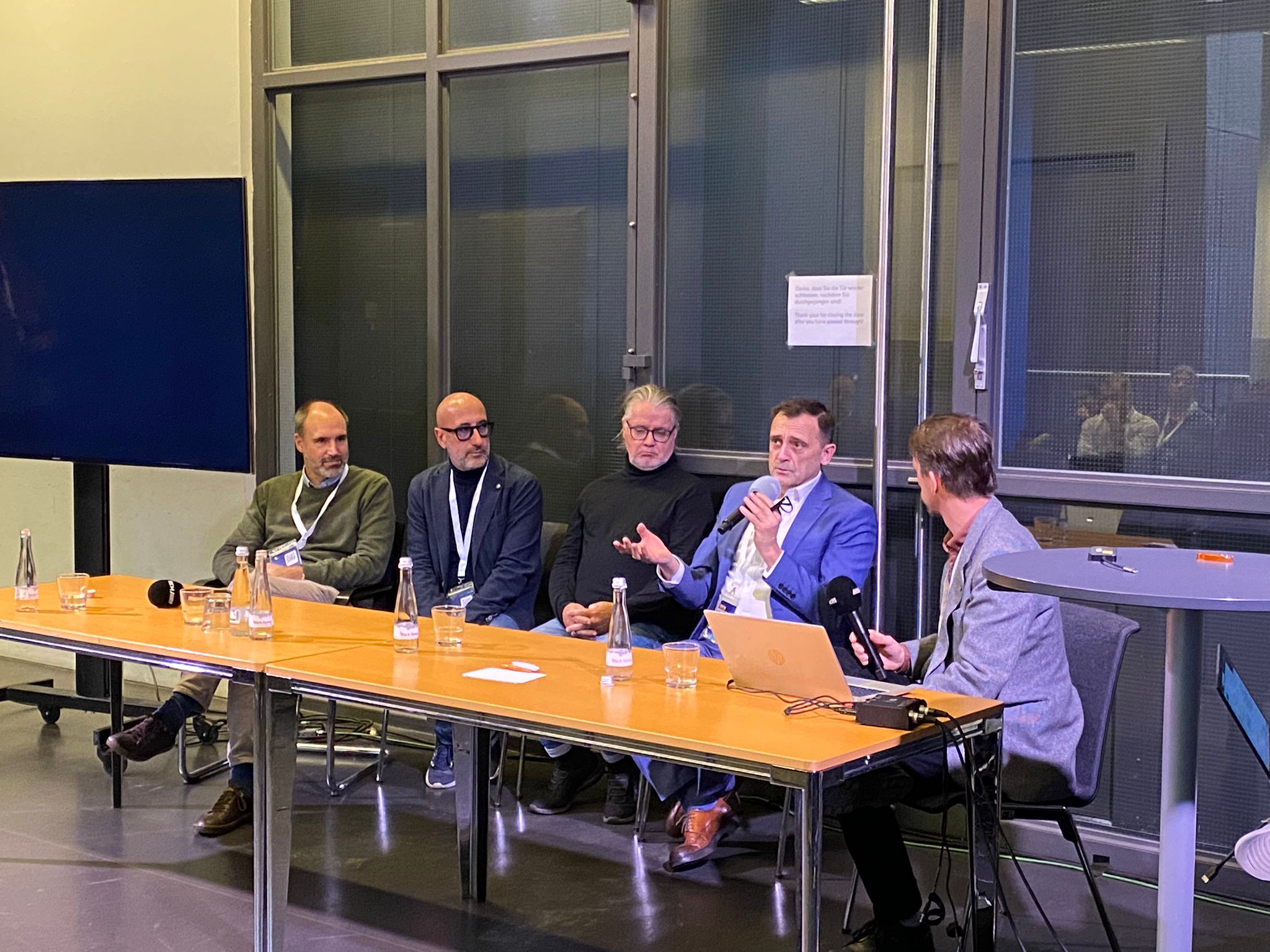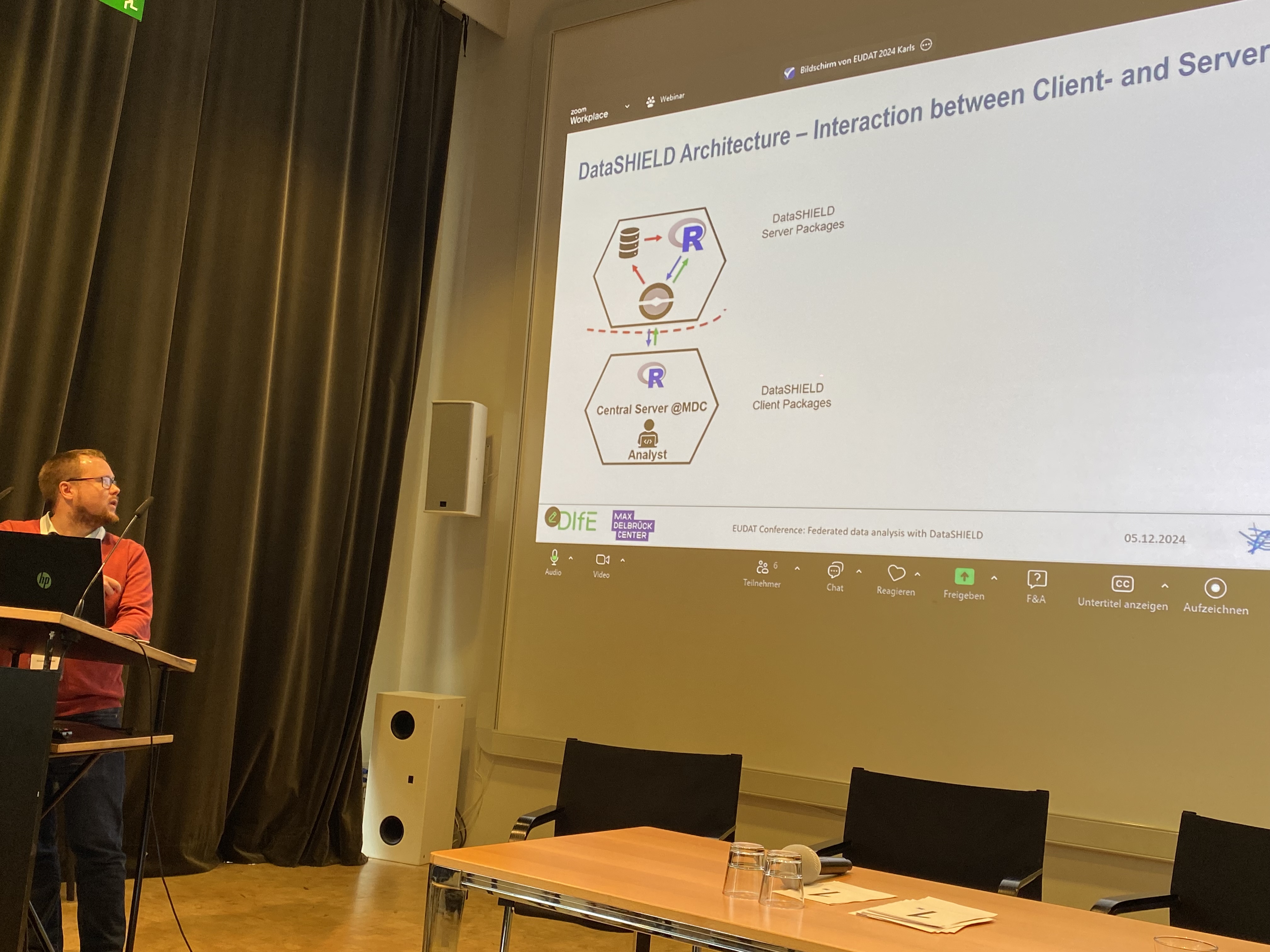
Explore key RDM takeaways and plans for the future.
We kicked-off the festivities and celebrated the latest RDM achievements in Karlsruhe! EUDAT Conference served as a time of reflection for all research & data management attendees, with over 120 people attending. The event sparked engaging discussions on latest practices in RDM, notably the development of European Data Spaces and the recent announcement of the EOSC EU Node.
Curious about the key takeaways from the event, and what lies ahead for EUDAT Community? Explore our wrap-up below.

Day 1 – Why EUDAT Should be your one-stop shop for all your research needs.
In the futuristic space of ZKM ( Zentrum fur Kunst und Medien), Yann le Franc and Achim Streit shared a welcome message as EUDAT Head of Secretariat and KIT Scientific Computing Center Director, respectively. The audience of 38 open science organisations was introduced to EUDAT’s past events and vision, with Yann le Franc inviting participants to keep cooperation and collaboration on the top of their agenda for the duration of the conference. As a representative of the local open science community, Achim Streit shared insights about KIT’s work and developments, as well as the significance of Karlsruhe for German and European scientific community.
From data to impactful science, Prof. Dr. Timo Dickscheid delivered an inspiring keynote speech on the journey of “ Building a Distributed Brain Atlas on the Grounds of AI and Big Data”. Revisit his presentations via slides here.
EUDAT Secretariat members, Mark van de Sanden (SURF) and Sander Apweiler (JSC) led the service overview, including B2DROP, B2ACCESS, B2FIND, B2HANDLE, B2INST, B2SAFE, B2SHARE.
The attendees got a chance to explore how the service supports the complete data life-cycle from planning to discovery and re-use, and learned more about the community types already utilising various customisable services from EUDAT’s catalogue.
Alongside EUDAT Services, 10 new FAIRCORE4EOSC Services were demonstrated by Tommi Suominen (CSC) and FAIRCORE4EOSC’s service developers. These services are aimed to improve the discoverability and interoperability of increased amount of research outputs. To explore these components, check out FAIRCORE4EOSC webpage.

Day 2 – From collaboration to cooperation : How do we ensure operable national eInfrastructures & seamless cross-border data management?
The second day was packed with 10 sessions, ranging from EOSC Advancements of supporting FAIR research data lifecycle, to understanding the importance of interconnectedness between HPC and data management solutions.
With the morning coffee in hand, the participants delved deeper into the cross-domain implementation of data spaces, from language to public governance, and discovered how SIMPL may be the key to its interoperability. This session, hosted by Per Öster (CSC), promulgated a discussion on whether EOSC itself could be considered a data space, with some proposing it to be one of the most advanced data space in terms of development and governance. For more insight about the data spaces revisit the presentations here.
In the morning session led by Najla Rettberg (Base4NFDI) and Jos van Wezel (KIT) we had perspectives from national infrastructures of Germany, the Netherlands, France, Spain, and Greece. While each of the national infrastructure is at varying levels of development, a common agreement and recommendation for builders of EOSC would be to : "Build on existing national and international resources which already work well and to exploit them, following the well-established principle of subsidiarity "( from presentation on national infrastructure in Germany, Najla Rettberg).
But how can we best facilitate collaboration and enable data-driven decision-making? In the cross-border / cross-domain data management session hosted by Abdulrahman Azab (Sigma2) and Mark van de Sanden (SURF), participants got the opportunity to learn more about EUDAT Collaborative Data Infrastructure ( CDI), a common model and service infrastructure for managing data spanning all European research data centers and community data repositories. Explore the various solutions that facilitate cross-border data management here.
The research data practices would be incomplete without a comprehensive approach and implementation of FAIR, as Yann Le Franc (eScience Data Factory) showcased in Semantics session. Semantic artefacts are key components to build a semantic interoperability framework and to support the implementation of the FAIR Principles. These artefacts leverage specific standards and technologies and require dedicated services that should be integrated with the research data management tool chain. In addition, semantic artefacts should be FAIR themselves. Explore solutions that ensure FAIR Semantics here.
The session on EOSC advancements to supporting FAIR research data lifecycle served as an overview of the recent development of EOSC and the EOSC Federation. Chaired by Tommi Suominen (CSC), the session reflected on the recent launch of EOSC EU Node, and introduced how the EOSC Federation Handbook will pave the way for EOSC nodes wishing to contribute and join the EOSC Federation. Alongside the Handbook, EOSC Innovation Sandbox is being developed by EOSC Beyond, in order to facilitate and ensure integration of any new core services and node candidates within the EOSC Federation.
Alongside the developments of national & European infrastructures, EUDAT conference also brought experts in the field of sensitive data, its management and processing conditions. In this session hosted by Abdularahman Azab (Sigma2), we have learned General Data Protection Regulation is not as strict as national legislation. Solutions are heading towards being able to respect differences in national rules on privacy and data security while still being able to provide legitimate access where needed. Revisit this session’s latest practices here.
Another highlight of the second day was a unique opportunity to showcase and compare the practices and solutions of various eInfrastructures in Europe, including EUDAT, EGI, GEANT, OSCARS, OPENAIRE, DARIAH-PL, IAGOS RI, and a success story from Biomedical Research Foundation, Academy of Athens.
During her presentation of Ingredio, a quick-find of ingredients app, Zoe Cournia reflected on concrete examples how the eInfrastructure resources helped her research at Academy of Athens, and also as a service provider and an SME. The utilisation of eInfrastructure in Ingredio’s case, shows the importance of allowing scholars to find and combine various data & discoveries, accelerating the transition to open science and open innovation, and bringing science & research closer to societal needs.
Take your data to-go! Through an engaged discussion facilitated by Martin Golasowski and Jan Martinovic (IT4I), the participants of Data Orchestration, Strengthening connections between HPC and data management solution session had an overview of open problems in the data management on HPC. The audience was also introduced to solutions of orchestrating data’oriented workflows, such as LEXIS Platform and the IO-SEA software stack, offering novel approaches to maintaining diverse database systems through the EXA4MIND Project.
Meanwhile, FAIRCORE4EOSC and EOSC Beyond co-located their workshop sessions alongside the previously mentioned sessions, further strengthening synergies between the two projects and establishing the next steps on how to support the EOSC Federation.

Final Day of EUDAT Conference – Crazy Ideas for more innovative data management solutions
The final day was a day of brainstorming, and daring to dream! Our presenters and attendees grouped together, put their creative hats on and brainstormed what data management solutions might be needed for our communities, even the solutions that could not be yet implemented during Crazy Ideas : RDM Solutions Collaborative Session organised by Anca Hienola (FMI).
How would you answer one of the session questions: If research data could manage itself, what would that system look like? How would the process work invisibly in the background?
We also focused on strategic plans for strengthening collaborative efforts between various eInfrastructures, and considered the ethical stakes with the rise of AI for the implementation and management of FAIR Data. During the FAIR Data, Ethics, and AI session by Jos van Wezel (KIT), the the interpretation of GDPR varies cross institutions – yet collection and use of data for AI models raises ethical consideration, especially in domains such as medicine. To learn more about these case studies, explore the presentations here.
In the FAIRCORE4EOSC contributions to EUDAT, Tommi Suominen (CSC) showcased a number of components have been developed that have fed into various EDUAT services as new features. The question on sustainability of such services was pertinent to the audience discussion. Check the latest services here.
While FAIR principles have been an underlying concern for all session topics, with Christopher Page (CERFACS) led session on Research Software – making it FAIR, the participants had an in-depth overview of RDA established guidelines, learned more on the benefits of FAIR research software, and the consequences of its use for users.
The energy of collaboration, debate and consideration was also present during the Matching eLTER RI Requirements to Future Architecture for Environmental Research Infrastructure. The session organized by Allan Souza (University of Helsinki) explored the synergies between eLTER( Integrated European Long- Term Ecosystem) research infrastructure and the EUDAT CDI, focusing eLTER needs and how this RIs can be used in research infrastructures to increase their FAIR maturity. Revisit the session presentations here.
You are all caught up! See you at the next EUDAT Conference 2026, which will take place in…
Well, you will have to keep up with the updates to see! Thank you to all attendees, speakers and presenters for their contributions. A special thank you for the continuous support to our partners, Research Data Alliance, FAIRCORE4EOSC, EGI, GEANT, OpenAIRE and PRACE.
